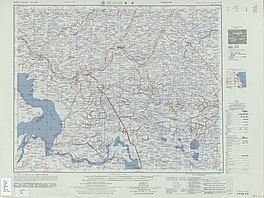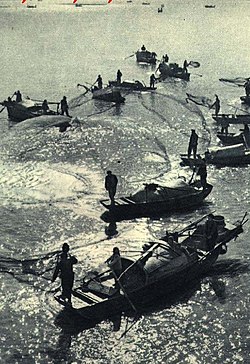Hongze Lake
| Hongze Lake | |
|---|---|
| Hungtze Hu, Hung-tse Hu | |
 | |
| Location | Jiangsu Province |
| Coordinates | 33°18′27″N118°42′36″E/ 33.30750°N 118.71000°E |
| Primary inflows | Huai River Si River,Yellow River(historically) |
| Primary outflows | Huai River |
| Basincountries | China |
| Hongze Lake | |||||||||
|---|---|---|---|---|---|---|---|---|---|
 Fishing on Hongze Lake (1962) | |||||||||
| Traditional Chinese | Hồng trạchHồ | ||||||||
| Simplified Chinese | Hồng trạchHồ | ||||||||
| |||||||||
| Fuling Lakes (antiquity) | |||||||||
| Chinese | Phú lăngHồ | ||||||||
| |||||||||
| Pofu Pond (Han–Sui) | |||||||||
| Chinese | Phá phủĐường | ||||||||
| |||||||||
| Hongze Pond (Sui–Tang) | |||||||||
| Traditional Chinese | Hồng trạchĐường | ||||||||
| Simplified Chinese | Hồng trạchĐường | ||||||||
| |||||||||
Hongze Lake,previously knownasLake HungtzeorHung-tse,is thefifth-largest freshwater lakeinChina.Although it is known to have existed from antiquity, it drastically increased in size during theQingwhen theYellow River—then still flowing south ofShandong—merged with theHuai.The increased sediment and flow combined to greatly expand the lake, swallowing the previous regional center ofSizhouand theMing Zulingtombs. During theimperialandrepublicanperiods, the lake formed part of the border betweenJiangsuandAnhuiprovincesbut since 1955 the previous borders have been shifted to place it entirely under Jiangsu's administration. It is now encompassed by thecountiesofSihongandSiyanginSuqian PrefectureandXuyiandHongzeinHuai'an Prefecture.Since the establishment of thePeople's Republic of China,the lake has generally decreased in size as more of its inflow has been diverted forirrigation.
Geography
[edit]Hongze Lake reaches an area of about 3 millionmuwhen its depth reaches 12.5 meters (41 ft),[1]making it the second-largest freshwater lake in Jiangsu[1]and the fourth-[2]or fifth-largest in the country,[1]behindlakes Poyang,Dongting,Tai,andHulun.Hongze Lake's meandering shoreline usually runs around 365 kilometers (227 mi).[1]
History
[edit]The area that now forms Hongze Lake was an inlet of theEast China Seaabout 2 million year ago before being closed in by sediment from theHuaiand other nearby rivers.[1]InChinese antiquity,the area formed a number of shallow lakes collectively known as Fuling.[2]Other nearby lakes at the time that later merged into Hongze were Nidun and Wanjia.[2]ThehegemonFuchaiofWuconstructed the Han orHangou Canal(tHànCâu,sHànCâu,Hángōu), connecting the lake system withYangzhouand theYangtze Deltain 486BCto improve the supply lines of his army in conflicts withQi.
Under theHan,Fuling was renamed Pofu Pond.[2]Acting as part ofLü Bu's faction, theGuanglingadministratorChen Dengcompleted the first part of theGaojia Weir(CaoGiaYển,Gāojiāyàn) around the yearJian'an5 (aroundAD200), a massive 30-liembankmentintended to protect nearby farmland and the Hangou Canal and nearby settlements and farmland from floods of the Huai.[3][4]
Under theSui,the Hangou Canal and lake were connected to other waterways north and south to create theGrand Canal.During an inspection tour in 616,Emperor Yangrenamed Pofu Hongze in his delight at the rain that greeted his arrival there, the rest of the countryside having suffered a drought.[1]When it further expanded under theTang,it became known as Hongze Lake.[1][2]A massive flood of theYellow Riverredirected itsouth ofShandongin 1128 or 1194,following the courseof theSito join the Huai belowHuaiyin.[2]The silt from the Yellow River began to obstruct the flow of the Huai andstarted to expandHongze still farther,[2]ultimately quadrupling its original size.[citation needed]During this period, it became an important fishery and center of irrigated cropland.[2]It still forms the origin point of theNorth Jiangsu Main Irrigation Canal.Under theYuan,the course of the Grand Canal in the area was straightened to circumvent the lake.

Under theHongwu Emperor,the firstemperorof theMingdynasty,theMing Zulinggarment tombwas built near the regional centerSizhoutohonor his ancestors,whom he posthumously elevated to imperial status.[5]Under his son theYongle Emperor,the Gaojia Weir was further expanded,[4]in part to protect the site. InWanli7 (c.1579),Pan Jixunenlarged and reinforced the weir with stone along its then 40 to 42 kilometers (25 to 26 mi) of length.[6][4]His mismanagement of the area's difficult hydrology allowed Sizhou to flood and threatened the tombs, leading to his demotion and dismissal.
By theQing,the Yellow River had built up enough silt that itchanged courseagain to merge with earlier tributaries of the Huai. InKangxi16 (c. 1677), theviceroy of riversJin Fu(tCậnPhụ,sCậnPhụ,Jìn Fǔ,1633–1692) extended the embankments fromZhouqiaotoJiangba(tTưởng bá,sTưởng bá,Jiǎngbà).[6]A few years later in 1680, the increased silting produced enlarged Hongze Lake so much that it entirely consumed Sizhou and the Ming Zuling.[5]TheKangxiandQianlong Emperorscontinued the expansion and reinforcement of the Gaojia Weir, reaching 67–70 kilometers (42–43 mi) and completing the modern Hongze Lake Embankment.[4]Altogether, fromWanli3 (c. 1575) toXianfeng5 (c. 1855), the Gaojia Weir and Hongze Embankment burst 140 times, involving breaches in 300 different sections.[6]During the worst breaches, the lake level fell as much as 10 meters (33 ft).[6]On one occasion in the 19th century, theDaoguang Emperorheld theJiangnanriver supervisorZhang Wenhao(tTrươngVănHạo,sTrươngVăn hạo,Zhāng Wénhào,d.1836) in chains at the repair site for a month during repairs necessitated by his mismanagement of when the dams need to be closed and opened; he was then dismissed to serve in theXinjiangborder guards.[6]For their part, local people made prayers and offerings to ninedragons(Cửu long,jiǔ lóng) near Zhouqiao for protection; thetemplewas lost in a flood.[6]In the early 1850s, the massive floods of the Yellow River that occasioned theTaiping Rebellionrestored the Yellow River entirely to its northern course, finally removing its inflow and siltation from the lake.
Under thePeople's Republic of China,counties in Anhui that bordered the lake were ceded to Jiangsu in 1955 to allow unified administration of the lake. By the early 1960s, its water level had dropped enough that the stone statues of the Ming Zuling'ssacred waywere again visible along the shoreline. After the end of theCultural Revolution,the provincial and national cultural preservation authorities excavated and restored the tombs, ultimately erecting a new 2,700 meters (1.7 mi)embankmentto protect it from any further flooding.[5]In 1966, 1976, and 1985, the Hongze Embankment itself was reinforced and improved with more modern engineering and materials, particularly with additional barriers to break up the force of the rivers' and lake's waves against the levees.[6]
References
[edit]Citations
[edit]Bibliography
[edit]- "General Introduction of Hongze Tourism",Official site,Hongze: People's Government of Hongze county, 2008, archived fromthe originalon 2012-09-10,retrieved2023-03-02.
- "Historical Evolution",Official site,Huai'an: Huai'an Municipal Government, 30 January 2018.
- "Hongze Lake Scenic Zone",Official site,Huai'an: Huai'an Municipal Government, 5 February 2018.
- "Hongze Lake",Official site,Suqian: Sihong Hongze Lake Wetland Scenic Area, 3 September 2020.
- "Hongze Lake Embankment",Official site,Suqian: Sihong Hongze Lake Wetland Scenic Area, 7 September 2020.
- Danielson, Eric N. (December 2008),"The Ming Ancestor Tomb",China Heritage Quarterly,Canberra: Australian National University, archived fromthe originalon 2013-09-27,retrieved2017-11-06.
External links
[edit]- Lake Hongze English guide(Jiangsu.net)

